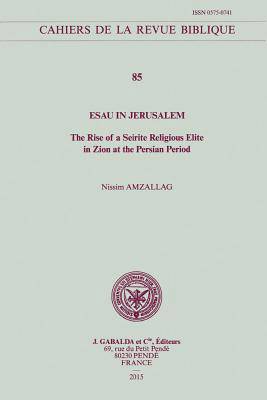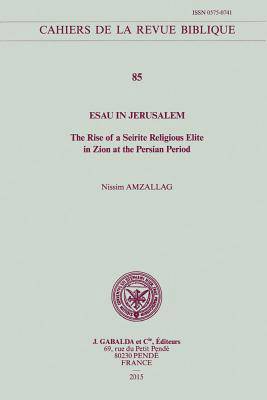
- Retrait gratuit dans votre magasin Club
- 7.000.000 titres dans notre catalogue
- Payer en toute sécurité
- Toujours un magasin près de chez vous
- Retrait gratuit dans votre magasin Club
- 7.000.0000 titres dans notre catalogue
- Payer en toute sécurité
- Toujours un magasin près de chez vous
Esau in Jerusalem
The Rise of a Seirite Religious Elite in Zion at the Persian Period
N Amzallag
Livre broché | Anglais
65,72 €
+ 131 points
Description
The post-exilic biblical writings speak in two contrasting voices. The first focuses on the Babylonian repatriates and ignores the Israelite population that remained in the land during the exile. It upholds an exclusive relationship between YHWH and the community organized around Jerusalem and its temple. The second voice takes a contrasting and much more universalistic approach to the relationship with YHWH and even promotes its expansion among foreign nations through the diffusion of musical worship. The first voice clearly echoes the theology evoked in Jeremiah (especially in the metaphor of the good and bad figs in Jeremiah 24) and extensively developed in Ezekiel. The second voice, however, appears to be distant from the classical Israelite theology. It is shown in this study that this second voice echoes a pre-Israelite cult of YHWH that originated in the land of Seir and denotes the existence of a Seirite religious elite in post-exilic Zion. Part 1 of the study investigates the reason for the presence of a small group of Edomite/Seirite musicians and poets, self-defined as sons of Zerah or Ezrahites, in early post-exilic Jerusalem, and clarifies the nature of their yahwistic religious background. With the help of the books of Nehemiah, Chronicles, and Psalms, Part 2 analyzes the Levitization of these foreign singers and the opposition this process stimulated among the community of the Sons of Exile. Part 3 examines the transformation of these Ezrahite singers into a new religious elite, a process promoted mainly by Nehemiah and his followers, and explores the theological changes this new situation stimulated. This study uncovers an overlooked reality that had a profound influence on the evolution of post-Exilic yawhism and on the composition and content of many biblical writings. The post-exilic biblical writings speak in two contrasting voices. The first focuses on the Babylonian repatriates and ignores the Israelite population that remained in the land during the exile. It upholds an exclusive relationship between YHWH and the community organized around Jerusalem and its temple. The second voice takes a contrasting and much more universalistic approach to the relationship with YHWH and even promotes its expansion among foreign nations through the diffusion of musical worship. The first voice clearly echoes the theology evoked in Jeremiah (especially in the metaphor of the good and bad figs in Jeremiah 24) and extensively developed in Ezekiel. The second voice, however, appears to be distant from the classical Israelite theology. It is shown in this study that this second voice echoes a pre-Israelite cult of YHWH that originated in the land of Seir and denotes the existence of a Seirite religious elite in post-exilic Zion. Part 1 of the study investigates the reason for the presence of a small group of Edomite/Seirite musicians and poets, self-defined as sons of Zerah or Ezrahites, in early post-exilic Jerusalem, and clarifies the nature of their yahwistic religious background. With the help of the books of Nehemiah, Chronicles, and Psalms, Part 2 analyzes the Levitization of these foreign singers and the opposition this process stimulated among the community of the Sons of Exile. Part 3 examines the transformation of these Ezrahite singers into a new religious elite, a process promoted mainly by Nehemiah and his followers, and explores the theological changes this new situation stimulated. This study uncovers an overlooked reality that had a profound influence on the evolution of post-Exilic yawhism and on the composition and content of many biblical writings.
Spécifications
Parties prenantes
- Auteur(s) :
- Editeur:
Contenu
- Nombre de pages :
- 296
- Langue:
- Anglais
Caractéristiques
- EAN:
- 9782850212420
- Date de parution :
- 30-09-15
- Format:
- Livre broché
- Format numérique:
- Trade paperback (VS)
- Dimensions :
- 160 mm x 239 mm
- Poids :
- 476 g

Les avis
Nous publions uniquement les avis qui respectent les conditions requises. Consultez nos conditions pour les avis.






